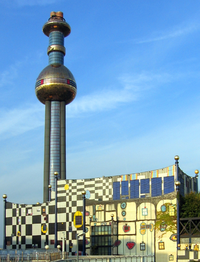
Photo from wikipedia
Abstract Wood waste fibers (CF) are low-cost modifiers which make poly(3-hydroxybutyrate) (PHB) composites more attractive for applications. In this work, biocomposites from plasticized PHB and defibrillated wood waste fibers were… Click to show full abstract
Abstract Wood waste fibers (CF) are low-cost modifiers which make poly(3-hydroxybutyrate) (PHB) composites more attractive for applications. In this work, biocomposites from plasticized PHB and defibrillated wood waste fibers were obtained and characterized. All the composites showed improved thermal stability, with up to 14 °C compared to PHB, a higher crystallinity and a shift of the glass transition with up to 9 °C towards higher temperatures. The reinforcing effect of CF was highlighted by an increase of storage modulus with 13 % at room temperature for the composite with 5 wt% CF and 25 % for that with 10 wt% CF. The highest increase, from 25 % to 90 %, was noticed between room temperature and 125 °C for the composite with 10 wt% CF. The better thermal and mechanical properties of composites compared to PHB are due to the presence of lignin on the surface of CF which favors PHB – CF interactions. This was also supported by the slight increase of contact angle along with the increase of CF concentration. A good interface was also highlighted by SEM: most of the fibers were well embedded in the matrix and locally covered by the polymer which also filled the lumen of CF. Doubling the amount of the plasticizer decreases the glass transition temperature, from −10 °C to −21 °C, the melting and crystallization temperatures of PHB as well, leading to more flexible composites. A decrease with 38 % of storage modulus at room temperature was also noticed when the amount of plasticizer was doubled, showing an increased flexibility. Combining the effect of CF and plasticizer, PHB composites with desired stiffness and toughness can be fabricated.
Journal Title: Industrial Crops and Products
Year Published: 2020
Link to full text (if available)
Share on Social Media: Sign Up to like & get
recommendations!